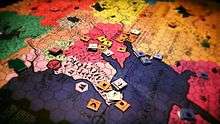Divine Right (game)

Divine Right is a fantasy board wargame designed by Glenn A. Rahman and Kenneth Rahman. The game was first published in 1979 by TSR, Inc.[1] and a 25th Anniversary Edition was published in 2002 by The Right Stuf International.
Overview
Divine Right is played on a full-color map of the fantasy world of Minaria, using counters to designate armies, fleets, barbarians, mercenaries, and other fighting forces. It is a turn-based war game that uses dice for all rolls. Magical creatures and items are also employed in an attempt to win the game through amassing more victory points than your opponents. Victory points are awarded for plundering castles and killing or capturing opposing monarchs.[2]
This two- to six-player game incorporates combat, castle sieges, and diplomacy in a fantasy setting. Players use everything from fleets to mercenaries to magical creatures to special military leaders. Players are affected by usual events in war: weather, mutinies, plagues, etc. Victory is obtained by one of two methods: score the most points by the end of the 20th turn, or eliminate all opponents.
To make all this happen, the game includes kingdom cards, personality cards, diplomacy cards, dice, unit counters, a full color game map and complete instructions.
The diplomacy system is perhaps the most novel element in Divine Right. Each turn a player draws a diplomacy card. The card either allows the player to bring a special mercenary unit into play or provides a modifier towards an attempt to bring a country into play on your side or leave an alliance with an opposing player. While each player controls their home country, most countries begin the game neutral and only fight for a player if brought into an alliance via a diplomacy die roll influenced by diplomacy cards. Another diplomatic action allows players to attempt to raise barbarian hordes at the board's edge, although a bad roll will cause the barbarians to burn the player's ambassador at the stake, thus preventing any diplomacy on the player's next turn.
History
Divine Right was developed by brothers Glenn and Kenneth Rahman based on their earlier, unpublished game Your Excellency. Glenn Rahman credits his background writing stories for semi-pro magazines with inspiring the effort to add characterization to the story through the use of "personality cards" and elaborate background stories. The use of a fantasy setting was inspired by Chaosium's White Bear and Red Moon, while the implementation of magic and the mythology of Minaria, the game world, was inspired by the works of J. R. R. Tolkien, Robert E. Howard, H. P. Lovecraft, and Clark Ashton Smith. This background was detailed in an appendix to the original game manual and in a series of 20 articles titled Minarian Legends appearing in Dragon magazine. Glenn also credits the artwork by his brother Kenneth with helping ensure its continued popularity, calling it "a quantum leap over the drab art that had illustrated most games until then."[3]
Divine Right was originally released in 1979 by Tactical Studies Rules, Inc. (TSR). The second edition was released in 1980 and included several original additions as well as elements from the articles appearing in Dragon magazine at the time. The game was sold for several years[4] and set many precedents in turn-based wargaming.
The game was updated by the original authors and was released in 2002 as a 25th Anniversary Edition by The Right Stuf International, which in addition to the original game included a bonus CD and an autographed certificate of authenticity.[5] The entire 2000 copy limited run of this version was sold.[6]
Legacy
The authors of Divine Right, Glenn and Kenneth Rahman, have continued to make improvements to the game's rules. As of 2010 a new edition is reported to be under development[7] and will be composed of three volumes:
- VOL. 1: Sixth Edition Rulebook, a comprehensive manual that will include new and expanded rules, a never-before-published strategy guide, and an index.
- VOL. 2: Scarlet Empire, a spin-off of Divine Right that Glenn Rahman wrote years ago but never published.[8]
- VOL. 3: Minarian Legends, a compilation of fiction set in the world of Divine Right. Most of the articles were originally published in serial form between 1980 and 1982 in TSR's Dragon magazine and were included on a CD-ROM with the 25th Anniversary Edition. A pronunciation guide will also be included.
All three volumes are expected to be published online at the Divine Right Yahoo! group; see the Links section below.
Several PBEM engines for Divine Right are now in development. The one that is known to work and is supported is available as a free download (see links below).
Art
The mapboard for the original 1979 edition was by David A. Trampier.[9] The cover art is by "Elrohir," a nom de plume of Kenneth Rahman, brother of Glenn Rahman.[10]
References
- ↑ Sacco, Ciro Alessandro. "The Ultimate Interview with Gary Gygax". thekyngdoms.com. Retrieved 2008-10-24.
- ↑ RPGnet : The Inside Scoop on Gaming
- ↑ Rahman, Glenn (March 2002), "Divine Right 25th Anniversary Edition Design Notes", Knights of the Dinner Table Magazine, Kenzer & Co. (65 Miami Dice): 56–58
- ↑ Excerpted from an appendix to the forthcoming sixth edition of Divine Right, provided by its editor, J. McCrackan
- ↑ Funagain Games: Divine Right
- ↑ Divine Right 25th Anniversary Edition
- ↑ The new edition's editor, J. McCrackan
- ↑ Glenn Rahman's correspondence with J. McCrackan, editor of the sixth edition of Divine Right
- ↑ http://www.geekdo.com/image/475760/divine-right
- ↑ Art of Dave Trampier, Chris Turner, Oct 5, 2005
External links
- MADHAT Divine Right Pages - fan website containing links to PBEM versions and new rules
- Yahoo!'s DivineRightGame group - a discussion site for Divine Right's fans and where the rules are posted
- Divine Right at BoardGameGeek
- Divine Right 25th Anniversary Edition Design Notes